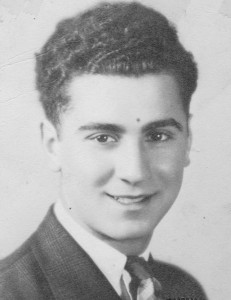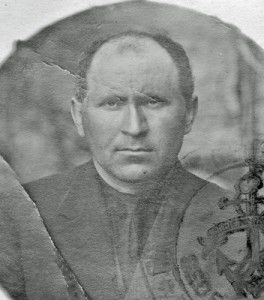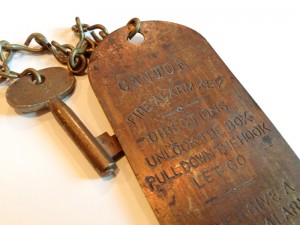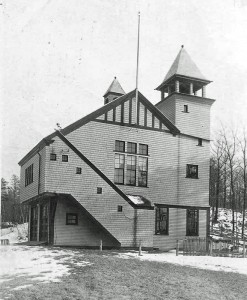True Tales from Canton’s Past: Ponkapoag Fire Part 1
By George T. ComeauThe following is the first in a two-part series on the Ponkapoag Fire of 1924. Click here to read part 2.
Albert D’Attanasio was in a strange new place. The Comune di Loreto Aprutino is a small village in central Italy in the Abruzzo region. At any other time in the life of a 4 year old, this would be an adventure. The little boy wandered the hillside so far from the fields of Canton. The scent of bay leaves was strong, yet not quite enough to wash away the smell of charred wood and smoke that clung to his memory of that terrible spring evening back in Ponkapoag.
The Ponkapoag of 1924 was not all that different than that of today — a small collection of family homes, a few businesses, a post office and fields. It was, however, a village that maintained a separate and cohesive identity due to the fact that much of the day-to-day existence revolved around the neighborhood. Neither Route 128 nor Ponkapoag Way had yet to be built. The area was a mix of luxurious farms for the wealthy and the men and women who supported them.
Today, just at the corner of Washington and Turnpike streets, is a small Italian specialty store, but in 1924 this was C.W. Crowell’s Store and post office. Just a year earlier, Route 138 was widened and Crowell’s was moved back from the road to allow for added traffic and safety. Just up the road, where Connor’s Wayside Furniture is today, was a newly opened First National store. There were apartments above the first floor to serve a burgeoning population that had moved into the neighborhood.
Most of the area families were longstanding and wealthy residents, or the newly arrived immigrant farm workers, milkmaids, domestic staff, and their rather large compliment of children. There were over a dozen commercial farms and a handful of dairies in Ponkapoag, so there was plenty of work and the village center was a burgeoning part of everyday life.
The D’Attanasio family came to America in the great wave of immigration at the start of the 20th century. Nicola D’Attanasio came from Italy in 1900 and settled in North Square, that part of the North End that is at the center of Italo-American history in Boston. In June 1906, Tomasso D’Attanasio arrived in New York and made his way to Boston to live with his brother Nicola. By 1910, we find Nicola D’Attanasio working on Elm Street as a farmhand. And in 1911, a third brother, Vincenzo, emigrates and joins his siblings.
Both Tomasso and Vincenzo stayed on in Canton and signed on as farm hands to two of the large estate farms. The 1920 Census lists Tomasso working at the Indian Line Farm at Ponkapoag and Vincenzo at the Roger Williams Farm on Washington Street. Both young men settled in Ponkapoag and raised beautiful families.
Vincenzo and his wife, Annantonia, lived on the second floor of a tenement house owned by former state Representative Talbot Aldrich. The small wood-frame building at 2246 Washington Street sat a few feet from the road and behind a modest white picket fence. Aldrich had spent his summers in Ponkapoag; his father was the famous American writer and poet Thomas Bailey Aldrich. The Aldrich family lived in a spacious estate quite near the house they rented out to the D’Attanasio family.
The two-family house was teeming with children. Vincenzo’s wife was expecting to give birth that same summer and had her hands full with three active children. The oldest, Albert, was just 4 years old. A younger sister named Viola, who was 3, and a 2-year-old brother named Romolo rounded out the “familia.”
The small house sang with a chorus of children. Across the hall, on the same floor as the D’Attanasios, lived the French-Canadian family of Joseph and Rosella LeCleire. Joseph LeCleire was a greenskeeper at the Hoosic-Whisic Club on Elm Street. The family had four children: 12-year-old Beatrice and 8-year-old Rita, along with a pair of 5-year-old twins, Leona and Leo. Seven children and four adults made for tight quarters, and yet there was harmony in that small house where French and Italian voices mixed with the sounds of a generation growing up.
Joseph Cunningham was the youngest patrolman on the Canton Police force. Having joined just 22 days before, it was his job to walk his beat every night and check on the welfare of the citizens of Ponkapoag. On that Saturday morning in late May, Cunningham made his newly appointed rounds. In the dark of the night at 2 a.m. he sauntered by the picket fence of the D’Attanasio and LeCleire house. Seeing nothing amiss, he proceeded up Ponkapoag Hill, passing the homes of the Huntoons and Hortons and making his way towards Ralph Crowell’s. Not 20 minutes had passed when Cunningham, turning to look down upon the sleeping village, saw the flicker of light. He took a longer look, and moments later, flames erupted into the sky through the back roof of the tenement.
Cunningham raced down the hill and passed by Thomas Griffin, a milkman preparing his rounds working for the Ferguson Milk Company. Shouting “fire,” it was Cunningham who woke up neighbors as he neared the fully engulfed structure. Bursting through the yard, the officer took his nightstick and violently rapped against the door, rousing D’Attanasio and LeCleire. Both the men inside instantly knew there was trouble. Thick smoke was building as they roused their wives and children.
Meanwhile, Cunningham took the key from his vest and immediately made way for Call Box 85 and sounded the alarm that would summon help from the Ponkapoag Fire Station on Sassamon Street — less than a quarter mile away. After sounding the alarm, Cunningham turned his attention back to the house and saw to his horror that none of the occupants had found their way from the building.
Rushing across the street and entering the hallway, Cunningham encountered thick and acrid black smoke. Equipped with a battery-powered searchlight, he began to make his way to the second floor. Feeling his way up the bannister, Cunningham reached two landings and had to make three turns to reach the top. Seconds felt like hours as he reached the landing and found Vincenzo on the floor unconscious, clinging to his son Albert. Both lifeless bodies were curled up where they had fallen, and Cunningham separated the pair and carried the father to the street. Returning for the boy, he grabbed the lifeless form from the clutches of death and dropped him outside next to his father. By this time, Vincenzo had roused and told the officer that his wife was coming right behind. It was then that Cunningham knew he had to make a third trip into the jaws of hell to search for more victims.
At the same time, the LeCleire family was gathering. The fire was consuming the entire rear of the structure, forcing LeCleire and his wife to take their four children from their bedroom above the fire to his own bedroom facing the street. The rear staircase was engulfed with flames, and gusts of black smoke cut off access to the front staircase. The only way out was through a small side window about 12 feet off the ground.
A crowd formed outside the house and still the fire department had yet to arrive. The cries of the children could be heard as the night air filled with impending doom. Across the street, Lawrence Horton commandeered a car driven by a group of men from Providence who had stopped to watch the fire. Driving to the firehouse, Horton called out to Charles Bryant to take the fire truck to the blaze. Horton in turn drove his own truck, which he had parked at the firehouse due to the fact that the second fire engine had been out of commission for the past week.
The mostly volunteer fire department gathered at the scene and began what was by all accounts a sad comedy of errors. The children, trapped in the house, began to cry and LeCleire knew that he could not wait to be saved by others; he would have to take action to save his family. Sweeping away the window screen, he turned first to his nearly naked wife and promised to save her. There was fear in her eyes, and trust in his as he lowered her from the window. Looking up at her husband, Rosella refused to let go of his arms as he leaned out to get her closer to the ground. In an instant she pulled him from the windowsill and they both tumbled to the side yard.
Panic ensued as LeCleire realized his babies were trapped in the structure and they cried out to him for help. Turning to Cunningham, they both realized that the only way to save these souls would be to find a ladder and climb into the inferno. Time was of the essence. Lying on the ground, little Albert D’Attanasio feared for his mother and his siblings. His father held him tight, the embers caught in their eyes as they began to weep …
Stay tuned to read the conclusion of this fascinating and harrowing tale from Canton’s past.
Short URL: https://www.thecantoncitizen.com/?p=25883














